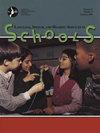Examining the Social Validity of Sketch and Speak Expository Intervention for Adolescent Students, Their Parents, and Their Speech-Language Pathologists.
IF 2.9
3区 医学
Q1 AUDIOLOGY & SPEECH-LANGUAGE PATHOLOGY
Language Speech and Hearing Services in Schools
Pub Date : 2025-04-29
DOI:10.1044/2025_lshss-24-00079
引用次数: 0
Abstract
PURPOSE This study explores the social validity of an expository note-taking and oral practice intervention, Sketch and Speak, for high school students with language-related learning disabilities (LLDs), their parents, and their high school speech-language pathologists (SLPs) after instruction via telepractice. The main study is reported in Peterson and Ukrainetz (2023). This report provides an additional in-depth analysis of participant perceptions. METHOD Three adolescents with LLDs entering ninth grade participated in this study. Data were collected from invested groups with pre-/post-intervention social validity questionnaires and post-intervention semistructured interviews. The interviews included brief video demonstrations of student performance in treatment. For the adolescents and their parents, Likert scale responses and open-ended question responses were analyzed qualitatively through content analysis. SLP interview responses were analyzed qualitatively using thematic analysis. RESULTS Content analysis of the student responses indicated potential independent use of strategies in school activities. Student self-ratings of learning behaviors did not change noticeably from pre- to post-intervention. Parents spoke about improvements in their children's overall learning confidence. The SLP responses revealed three main themes about potential clinical use: buy-in, barriers to implementation, and generalizability. All three participant groups shared perceptions of increased student confidence and ownership of learned materials. CONCLUSION This preliminary exploration suggests that Sketch and Speak may be a socially valid and academically useful intervention for adolescents in high school, even when delivered via telepractice.对青少年学生、家长及言语病理学家进行素描和说话说明文干预的社会效度检验。
目的探讨说说性笔记和口语练习干预“素描和说话”对语言相关学习障碍高中生、其父母和高中言语语言病理学家进行远程教学后的社会效度。主要研究报告在Peterson和Ukrainetz(2023)。本报告还对参与者的看法进行了深入分析。方法选取三名初中生为研究对象。通过干预前/干预后社会效度问卷和干预后半结构化访谈对被干预组进行数据收集。访谈包括简短的视频演示学生在治疗中的表现。通过内容分析,对青少年及其父母的Likert量表和开放式问题的回答进行定性分析。使用专题分析对SLP访谈反应进行定性分析。结果学生回答的内容分析显示学生在学校活动中有可能独立使用策略。学生的学习行为自评在干预前与干预后并无显著改变。家长们谈到了孩子们整体学习信心的提高。SLP反应揭示了潜在临床应用的三个主要主题:购买,实施障碍和推广。所有三个参与小组都认为提高了学生的信心和对学习材料的所有权。结论本初步研究表明,素描和说话对高中青少年可能是一种社会有效和学业上有用的干预,即使是通过远程实践进行的。
本文章由计算机程序翻译,如有差异,请以英文原文为准。
求助全文
约1分钟内获得全文
求助全文
来源期刊

Language Speech and Hearing Services in Schools
Social Sciences-Linguistics and Language
CiteScore
4.40
自引率
12.50%
发文量
165
期刊介绍:
Mission: LSHSS publishes peer-reviewed research and other scholarly articles pertaining to the practice of audiology and speech-language pathology in the schools, focusing on children and adolescents. The journal is an international outlet for clinical research and is designed to promote development and analysis of approaches concerning the delivery of services to the school-aged population. LSHSS seeks to advance evidence-based practice by disseminating the results of new studies as well as providing a forum for critical reviews and meta-analyses of previously published work.
Scope: The broad field of audiology and speech-language pathology as practiced in schools, including aural rehabilitation; augmentative and alternative communication; childhood apraxia of speech; classroom acoustics; cognitive impairment; craniofacial disorders; fluency disorders; hearing-assistive technology; language disorders; literacy disorders including reading, writing, and spelling; motor speech disorders; speech sound disorders; swallowing, dysphagia, and feeding disorders; voice disorders.
 求助内容:
求助内容: 应助结果提醒方式:
应助结果提醒方式:


